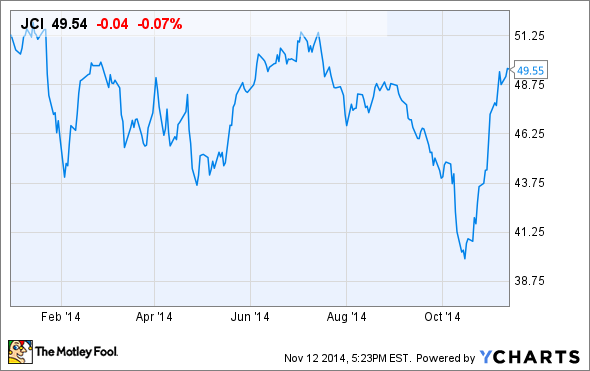Johnson Controls (JCI +0.73%) investors have watched their stock put in a strong recovery in the last month, and the share price is only down a few percentage points on the year, as I write. About a month ago, Fools looked at just why the stock had slumped in 2014, and more recently at the five things management hopes will improve company performance. Now, it's time to look at things from another perspective and ask: What are the three things that could take the stock higher?
The bullish case for Johnson Controls
In order to put the following arguments in context, here is a look at segmental income for 2014. It's pretty evenly split among the three segments, but keep in mind that power solutions (automotive batteries) and automotive experience (car seating and interiors) are both focused on the auto market.

Source: Johnson Control Presentations; figures exclude nonrecurring items and unusual items.
When last we looked at three reasons the stock could rise, the arguments related to an overall improvement in construction markets (building efficiency segment), the restructuring of the automotive experience segment (adjusted segmental income rose 68% in 2014), and the potential for power solutions to see increased demand with an improving economy.
This time around, the three arguments build on some of the points mentioned above:
-
Johnson Controls' core institutional construction markets are improving and will be an increasingly important part of its building efficiency earnings.
-
Cash-flow generation looks set to improve, which should make its valuation more attractive.
-
The potential for more margin expansion in the automotive experience segment could lead to significant increases in the segment's income.
Institutional construction markets
The Architecture Billings Index from the American Institute of Architects is the most widely used indicator of future construction activity. As you can see below, residential activity has been strong for a couple of years (in line with a recovering housing market), but it's only in the last few months that Johnson Controls' core institutional end market has started to pick up.

Source: American Institute of Architects; a reading above 50 indicates expansion.
Moreover, with the planned divestiture of its facilities management business, Global Workplace Solutions, or GWS, the importance of its North American operations is going to increase. For example, in the first nine months of 2014, its North American systems and service operations accounted for 55% of building efficiency segmental income. However, stripping out GWS from the total would see it increase to more than 60%.
In other words, if the GWS divestiture goes as planned, then Johnson Controls will see an improving North American institutional market have a bigger weighting within its profit mix.
Free cash flow improvement
It's well known that Johnson Controls management would like to improve its free cash flow generation. Indeed, investors should warm to this aim, because it's an area that has proved disappointing in the past. For example, back in August, management had predicted that full-year free cash flow would come in at $1.6 billion (the company's year end is in September). In addition, free cash flow was forecast to be $1.7 billion and $2 billion in 2015 and 2016, respectively.
In reality, free cash flow only came in at $1.5 billion for 2014, and that includes $265 million from the divestiture of its car electronics business.
It will be interesting to see what management says on the issue in its forthcoming financial analyst meeting on Dec. 2, because its current forecasts imply a significant increase in free cash flow conversion from revenue.

Source: Morningstar Research, Google Finance, author's analysis. 2014 figures exclude contribution from electronics divestiture.
Auto Experience margins
Management has gone on record as aiming for auto experience segment margins to increase to at least 7% in the next few years. Such figures would mark a continuation of a remarkable turnaround in the segment's fortunes.
| Metric | 2013 | 2014 |
|---|---|---|
| Net Sales ($ billion) | 20.46 | 22.03 |
| Segment Income ($ million) | 698 | 886 |
| Segment Margin | 3.41% | 4.02% |
Source: Johnson Controls Presentations.
In addition, auto experience segment margin came in at 4.7% in the fourth quarter.
It's difficult to make precise estimates, but some back-of-envelope calculations will reveal the potential for income growth in the segment. For example, assuming that the segment's revenue grows 5% per year and 7% margin is hit in 2018, then auto experience segment income would be around $1.87 billion in 2018 -- some 111% higher than in 2014.
Putting these elements together, it's clear that Johnson Controls could see an improvement in its building efficiency segment in the next year or so. Thinking longer term, the opportunity for improvement in margin expansion -- particularly in auto experience -- and free cash flow conversion overall is tangible. If these upside drivers come into place for the company, then the stock could go higher from here.






